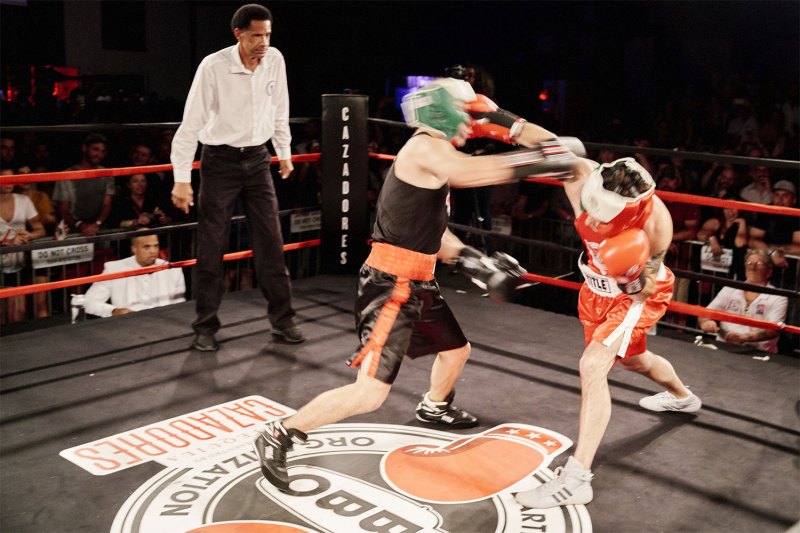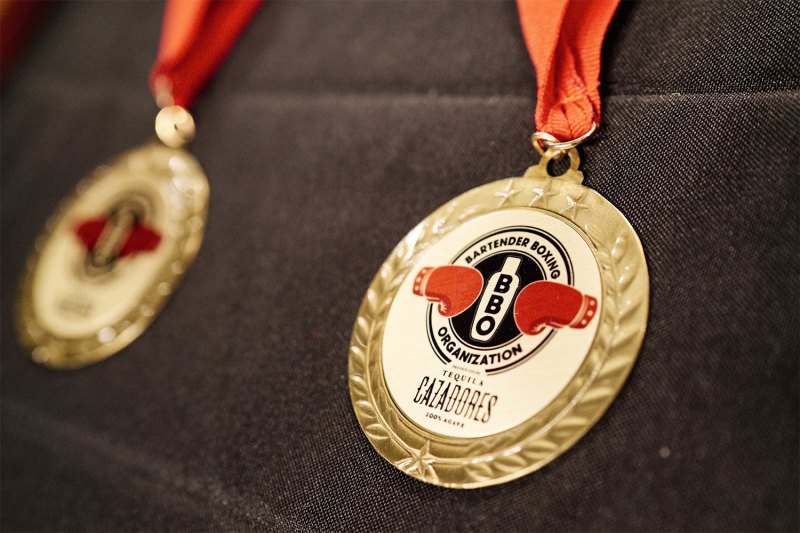Say you took the best bartenders from cities around the country and entered them into a rigorous boxing schedule with plans to fight one another in a boozy rendition of Fight Club. Sounds a little crazy, right? Well, it’s actually happening … and it’s a really good thing.
In an industry where deep-fried food truck munchies replace protein salads and getting a full eight hours of sleep means 5 a.m. to 1 p.m., Tequila Cazadores and Bartending Boxing Organization partnered on a program that helps bartenders go to the gym, cut back on booze, and develop overall healthier habits.

For three months, bartenders attend brutal workouts three times a week on top of their bartending schedules. They are given at-home and travel workouts that put mere mortals on the verge of puking, plus meal plan and nutritional advice. This programming is developed by Tommy Neff, a former boxer and boxing coach from upstate New York.
“We’re not trying to make killers,” Neff tells The Manual. “We realize bartenders work full-time, late hours, but this gets them in shape and changes their lifestyle.”
Bartender Boxer Training
Every Monday, Wednesday, and Friday, Death & Co. Denver’s Bar Manager Alex Jump catches a ride to her boxing gym where a group of fellow bartenders await the torture of another workout. A combination of running, sit-ups, push-ups, conditioning, endurance training, and sparring will get Jump into fighting shape.
“We focus first on learning technique and building stamina for doing the full rounds,” Jump says. “Then I started thinking about my diet and cutting out sugar and dairy. I’m thinking of doing keto for a while to get into a weight class.”

Bartenders are also given two workout plans constructed by Neff to do outside the gym:
- A mix of “Long Distance Runs” and “Short Distance Sprints.”
- A 10-round, tiered (Beginner, Intermediate, or Advanced) “Home or On The Road Workout” that requires no equipment.
Stop what you’re doing (and drinking) and try the first four rounds of the bartenders’ Home Workout. Perform every round for 1:30 minutes with a 1-minute break between:
- Round 1: Jumping jacks. Cross your feet over in front of you. Extend your arms all the way above your head.
- Round 2: Shadow box. Stay nice and loose, throwing lots of combinations. Mix up speed punches with power punches.
- Round 3: Mountain climbers. In the push-up position, drive your knees up towards your chest one leg at a time. Keep a quick pace.
- Round 4: Knees to elbows (riding bike). Laying on your back, touch your right elbow to your left knee, then your left elbow to your right knee. Keep your abs tight the whole time.
The majority of the bartenders chosen to participate in Bartender Boxing began without a pre-existing fitness regimen. After all, who wants to run on the treadmill after a night of cocktails? But Neff says, “We prefer they don’t have other combat experience.”
“The first session is pretty rough,” he laughs — that gentle yet killer laugh every wise boxing coach seems to have. “Every single first day we have people puking, but that’s because it’s something new. It gets easier and they get used to it. The beginning workouts are about trimming the fat and busting their butts cardio-wise. We don’t care if they puke, as long as they get back into it.”
Andrew Freeman of Container Bar in Austin is on the same schedule with his band of local bartenders. For each Bartender Boxing program, two cities are chosen and the bartenders in each will square off against the other.
“Before Bartender Boxing, I might go to the gym maybe once or twice a week,” Freeman says. “I’d finish work at 5:30 a.m. and sleep until 1 p.m., then it’s time to go back to work. Now I’m working toward something — the big fight — it’s a fitness goal that is attainable.”
Tequila Cazadores Senior Brand Manager, Peter Macfarlane, adds that “as bartending has become more of a career than a job, there is a greater awareness of its taxing nature.”
Motivation Behind Bartender Boxing
Now in its second year, Cazadores and Bartender Boxing hand-pick each bartender for the program, not based on how skillfully they mix an Old Fashioned or their social media following, but on their motivation for changing their lifestyle.
“I recently went through a breakup of a significant relationship and looked at boxing as an opportunity to start over for myself and learn who I am,” Jump says. “Obviously it’s cathartic, you’re punching things.”

Freeman has a similar motivation: not to be that guy who stays inside all day and plays video games. “I think it’s biologically ingrained in us to need competitive contact or a visceral expression to get something out. It doesn’t make you primitive. It’s an outlet,” he says.
Both bartenders attest the hardest part is getting out of bed and into the gym, but after the workouts, they feel 100 percent better.
Bartender Boxing’s Results
Once training is complete, Jump and Freeman’s groups will duke it out with each other. But apart from who lands a TKO and who possibly gets their nose broken (and a wicked cool scar), the bartenders walk away with much more.
At the mid-point in the program, Freeman has cut out fried foods and beer. He also says, “Honestly, I’m so exhausted after leaving the gym that the idea of partying is tiring.” He’s cut down on cocktails, too.

Jump similarly stopped drinking beer and nights before a workout will only have one whiskey. “Hungover boxing is so miserable; being hit in the head while nauseous, no thank you.”
Past participants have kept with new habits by joining a gym or group fitness class, cutting down on alcohol, and planning meals for evening shifts. Others have transformed entirely into legitimate amateur boxers.
“Bartenders don’t take care of themselves,” says Jump, “but you can live a healthy life and be in this industry. This whole program began because there was a bartender who started boxing and realized ‘I drink too much,’ and presented the program to Bacardi. Their whole portfolio including Cazadores inspires bartenders to live better lives. It’s amazing as a bartender to work with brands that care about us.”


